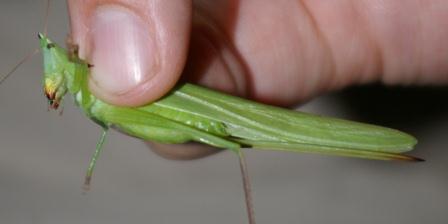by Carl Strang
Last winter I was contacted by Gideon Ney, a graduate student at the University of Missouri in the laboratory led by Johannes Schul. Their focus is the evolutionary relationships among katydids, and members of that research group have published significant analyses of coneheaded katydids, genus Neoconocephalus. One species which they had not yet studied is the slender conehead, Neoconocephalus lyristes, and Gideon found my post in this blog on that species last winter. There I mentioned my interest in finding lyristes, and we corresponded through the succeeding months as we planned our hunt for it. Gideon and another student from that lab, Nathan Harness, who is beginning a study of Orchelimum meadow katydids, came up last week. They started at Chain O’Lakes State Park in Illinois, and I joined them the next day at Illinois Beach State Park. We set up camp, did some scouting, then relaxed in the afternoon.
Coneheads for the most part sing after dark, and we began to drive the roads with windows and ears open as dusk deepened to night. The first conehead we found was the sword-bearing conehead, a common species of dry meadows.

The face of a sword-bearing conehead. The English name for the group refers to the structure protruding from the top of the head between the eyes. In this species the cone has a crescent-shaped black mark near the tip.
The sword-bearing conehead is named for the female’s ovipositor. Gideon caught one and held it for my photo.
Most of the coneheads we found had unornamented cones like those of the robust conehead, which I found at Kankakee Sands last month. However, the song was not nearly as loud, and the tentative conclusion was that these belonged to a different species, the false robust conehead. We heard a good variety of singing insects, but no slender coneheads, and so made plans to shift to Indiana Dunes National Lakeshore the next day (to be continued).

